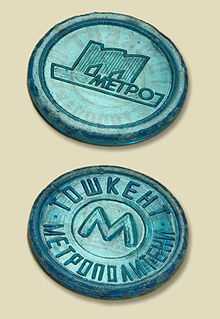Tashkent Metro
| Tashkent Metro Toshkent Metropoliteni Ташкентский Метрополитен | |
|---|---|
 | |
| Background | |
| Owner | State ownership |
| Locale | Tashkent |
| Transit type | Rapid transit |
| Number of lines | 3 |
| Number of stations | 29 |
| Daily ridership | 450 000 (average) |
| Operation | |
| Began operation | 1977 |
| Operator(s) | "Toshkent Metropoliteni" |
| Technical | |
| System length | 36.2 km (22.5 mi) |
The Tashkent Metro (Uzbek: Toshkent metropoliteni, Russian: Ташкентский метрополитен) is the rapid transit system serving the city of Tashkent, the capital of Uzbekistan. It is one of only two subway systems currently operating in Central Asia, the other one is the Almaty Metro. It was the seventh metro to be built in the former USSR, opening in 1977. Its stations are among the most ornate in the world.
Lines and stations
| 5# | Name | Opened | Length | Stations |
|---|---|---|---|---|
| 1 | Chilonzor Line | 1977 | 15.5 km | 12 |
| 2 | Ozbekiston Line | 1984 | 14.3 km | 11 |
| 3 | Yunusobod Line | 2001 | 6.4 km | 6 |
| 4 | Sirghali Line | Projected | ||
| Total: | 36.2 km | 29 |
History
Planning for the Tashkent Metro started in 1968, two years after a major earthquake struck the city in 1966. Construction on the first line began in 1972 and it opened on November 6, 1977 with nine stations. This line was extended in 1980, and the second line was added in 1984. The most recent line is the Yunusobod Line, the first section of which opened in 2001. A northern extension of this line is currently under construction, and a fourth line is expected to follow in 2010. Today, the Tashkent metro has 29 stations that differ from each other. The architecture and décor of each station depicts its name. The peculiarity of the Tashkent metro is its rather shallow station positioning. Some stations have escalators, 7 stations belong to the tower type, 4 stations to the arch type and one station (Mustakillik) to the tower-individual type. Prominent architects and artists of Uzbekistan took part in designing the stations. Interior décor features solid and stable materials: metal (in the form of engravings), glass, plastic, granite, marble, smalt, art ceramics, and carved alabaster. Each station is original work of art and centers on a particular theme.
System

Uzbekiston Line (blue): The route of this line crosses the city diagonally from northwest to southeast via the Toshkent Railway station. It opened in 1984 and expanded between 1984 and 1991. It is 14.3 km (8.9 mi) long with 11 stations.
Yunusobod Line (green): Work is under way on this line to connect the northern districts to the airport in the south. The first 6.4 km (4 mi) section with six underground stations opened for regular service on 24 Oct 2001 (test runs began on 28 August 2001 - the 10th anniversary of independence, but opening was delayed due to 9/11 attacks) between Ming Urik (initially planned to be named Lokhutiy) and Habib Abdullayev (initially planned to be named Shahriston).
The depth of the tunnels varies between 8 and 25 metres. The strong construction of these three lines can resist earthquakes of a magnitude of 9.0 on the Richter scale.[1] 81-717/714 4-car trains are used on 100 m platforms. It sports a 1,524 millimetres (60.0 in) gauge and a third rail power supply (825 V DC). The average station distance is 1,400 metres (4,600 ft) and trains have a commercial speed of 46 kilometres per hour (29 mph).

Rules and Restrictions
It is illegal to take pictures inside the metro system or any of the stations because they are considered military installations.
See also
| Wikimedia Commons has media related to Tashkent Metro. |
- List of rapid transit systems
References
External links
| ||||||||||||||||||
